Abstract
1. A new perfused preparation of frog's ventricle is described, whose main advantage is that there are short diffusion distances between the cells and the washing fluid.
2. This preparation responds within a few seconds to alterations in sodium, potassium or calcium concentration, or alteration in the osmotic pressure of the bathing fluid. The speed of these alterations is consistent with the diffusional distances involved measured histologically.
3. On depolarizing the preparation with Ringer + excess potassium, tension development starts at about -25 mV and is still increasing at -8 mV (the lowest voltage studied). As in earlier experimetns in frog ventricle (Niedergerke, 1956b) and in skeletal muscle (Hodgkin & Horowicz, 1960) the relation between potential and tension is very steep.
4. Sodium free contractures (Lüttgau & Niedergerke, 1958) are very rapid in onset with this preparation. To maintain the tension developed, a rapid rate of washing is necessary for 1-2 min. After this, slow washing is sufficient. It is proposed that this is due to the leaching out of cellular sodium.
5. In fresh preparations the twitch and maximum K contracture are of similar size when stimulated at 30/min in 1-2 mM-Ca. With the onset of hypodynamia the twitch tension falls, but the K contracture remains unaltered. In hypodynamic ventricles the sensitivity of the twitch to the ratio [Ca]/[Na]2 declines, whereas that of the K contractures remains unaltered. Hypodynamia therefore does not affect the contractile elements themselves.
6. During the staircase phenomenon the K contracture and twitch size alter in a similar manner, as previously described by Niedergerke. The sodium free contracture, however, remains unaltered. This tends to favour the hypothesis that the staircase phenomenon is due to effects at the cell membrane rather than in the cell interior.
7. Maximum K contractures occur at a [Ca]/[Na]2 ratio of about 0·7 × 10-4 mM-1, a figure similar to that obtained in earlier experiments (Lüttgau & Niedergerke, 1958).
8. The length—tension curves of K contractures are similar to those previously described for heart muscle, using single twitches to generate tension.
9. Application of K free solutions produced no rapid contractures in this preparation.
Full text
PDF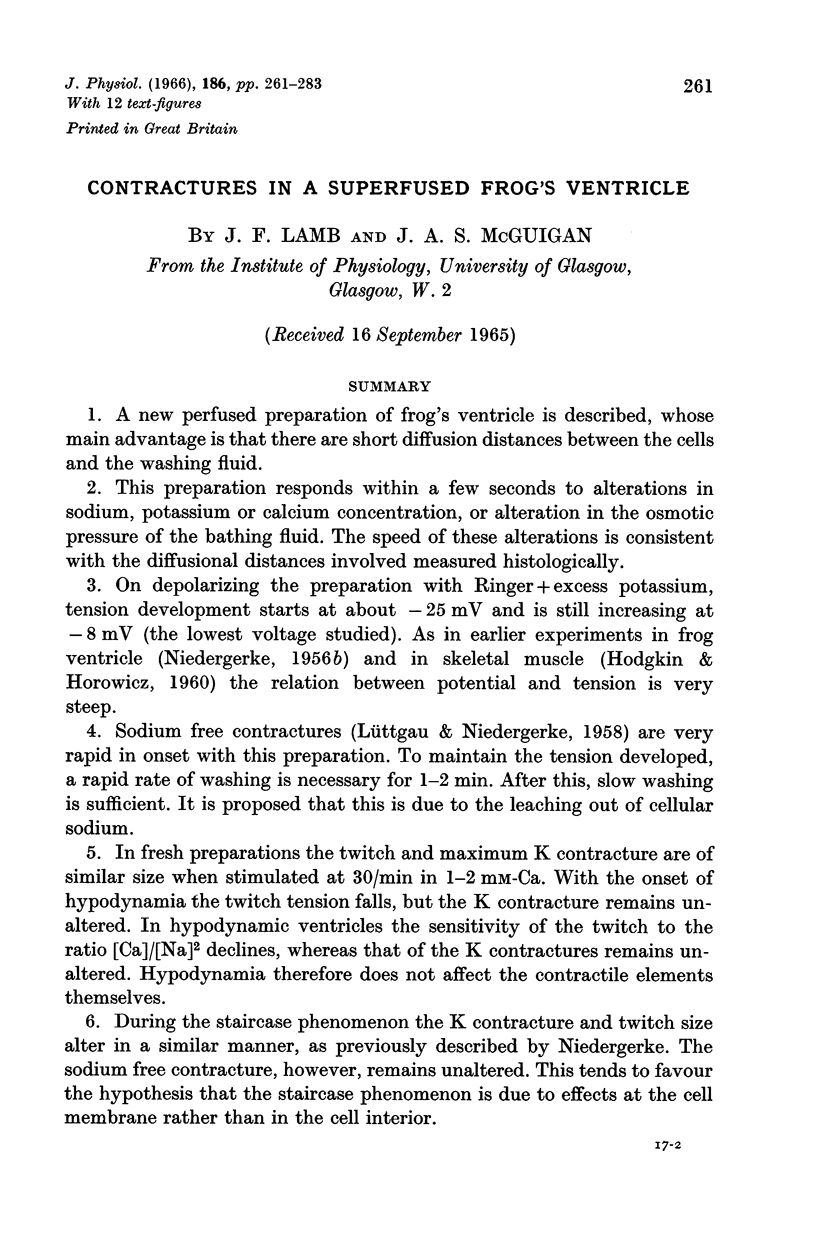
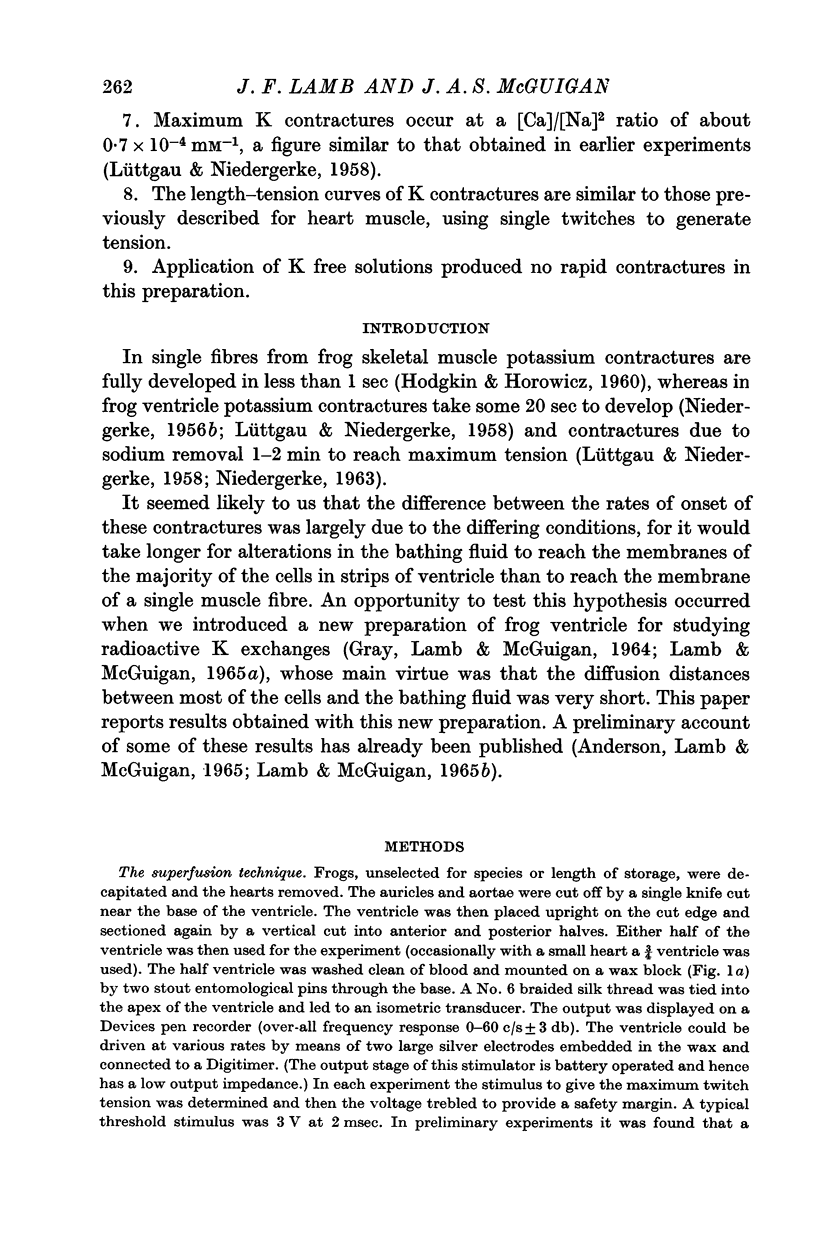
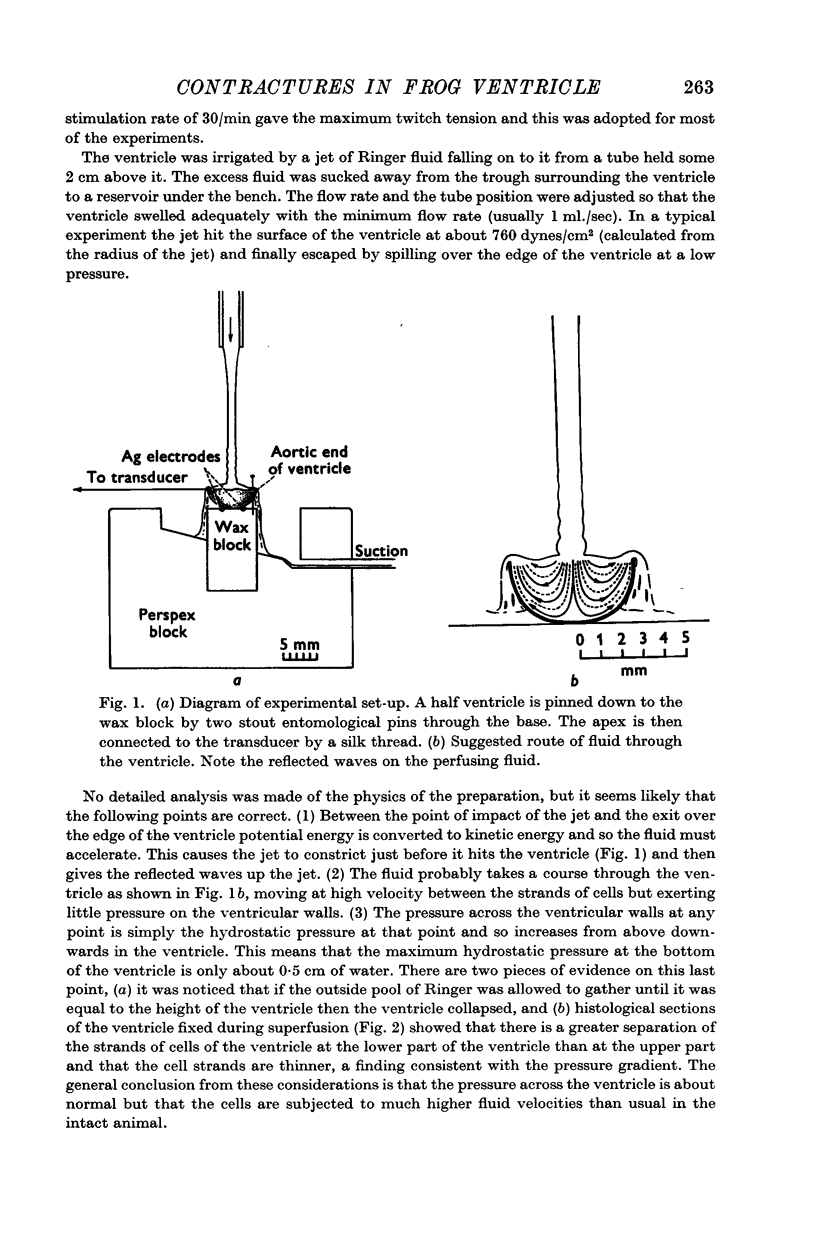
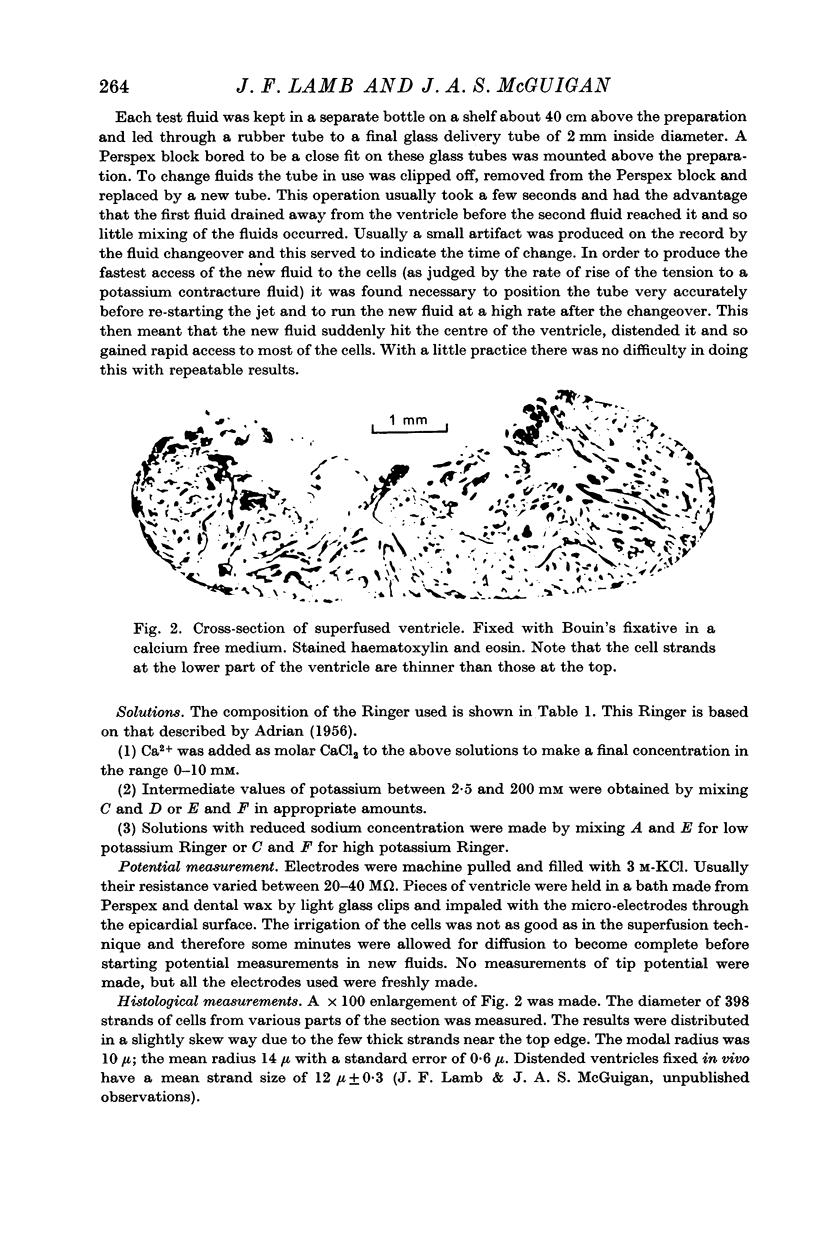
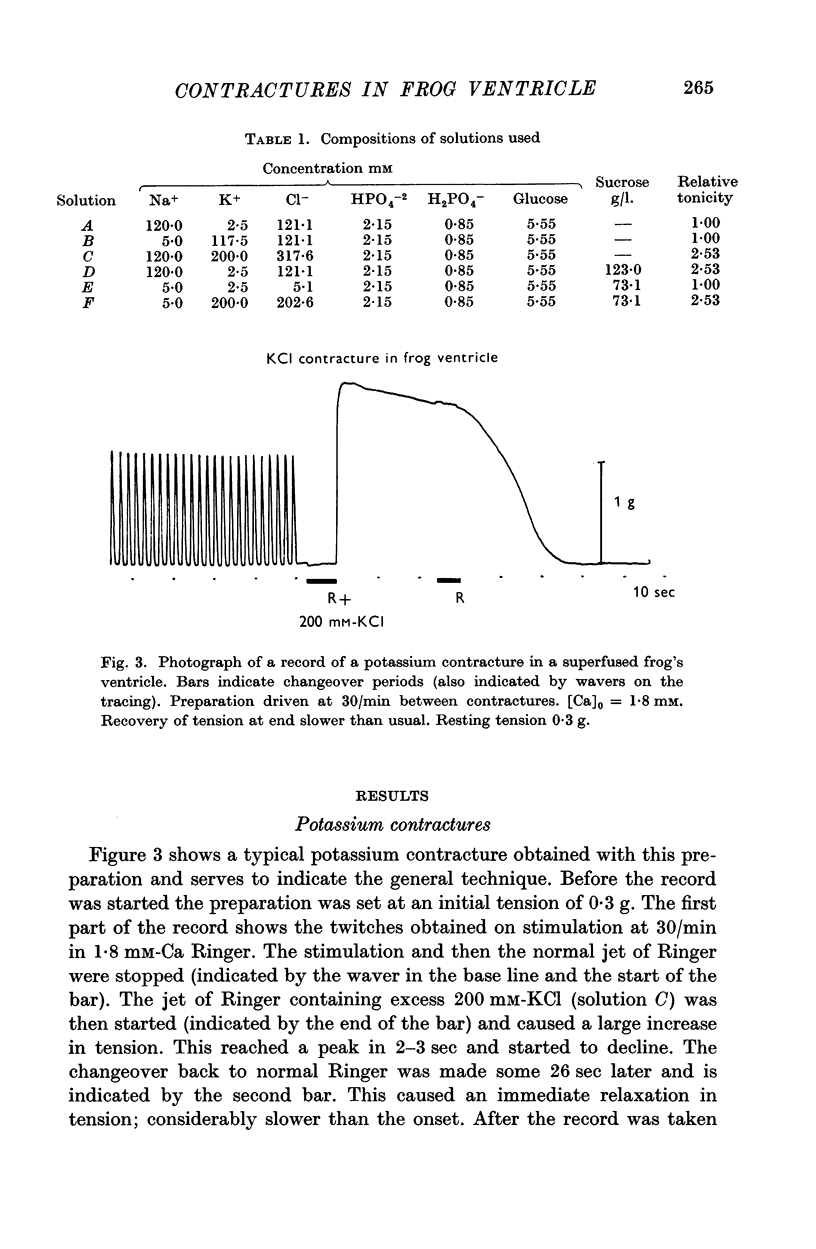
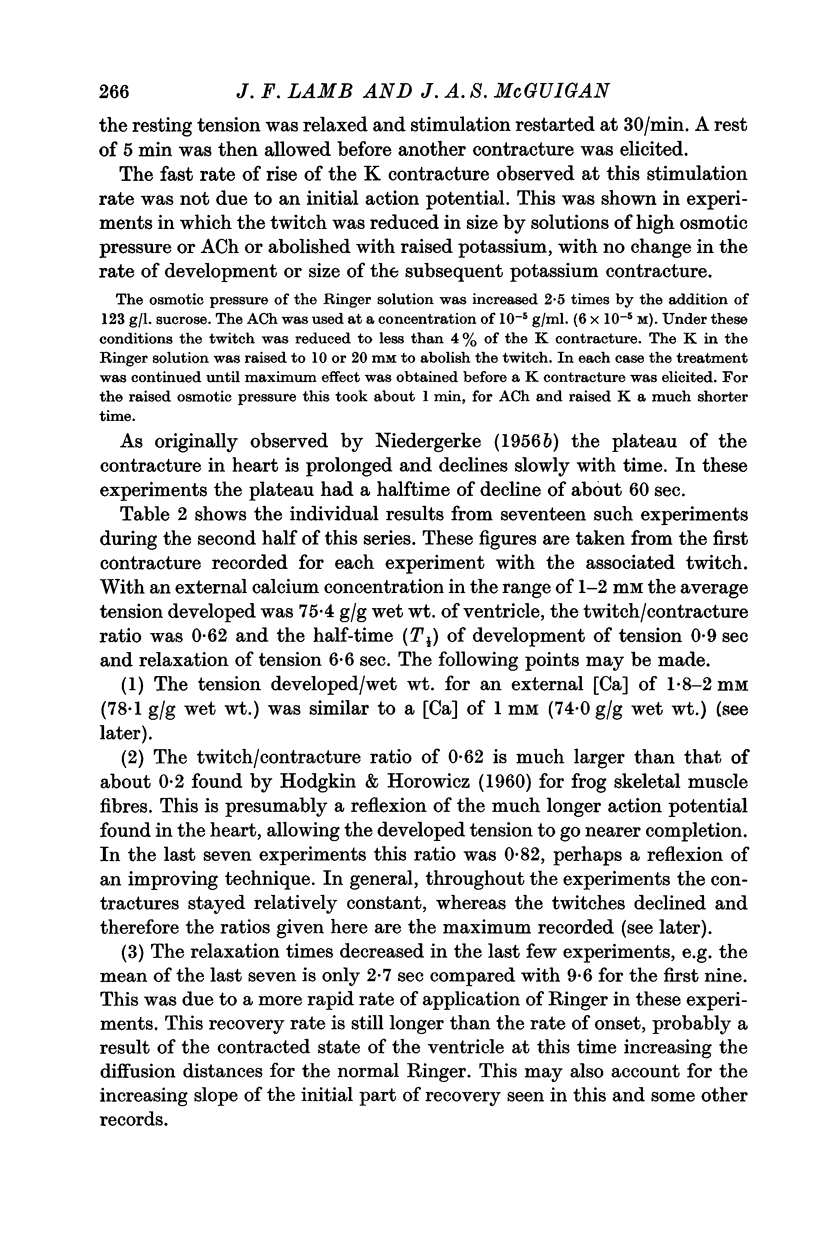
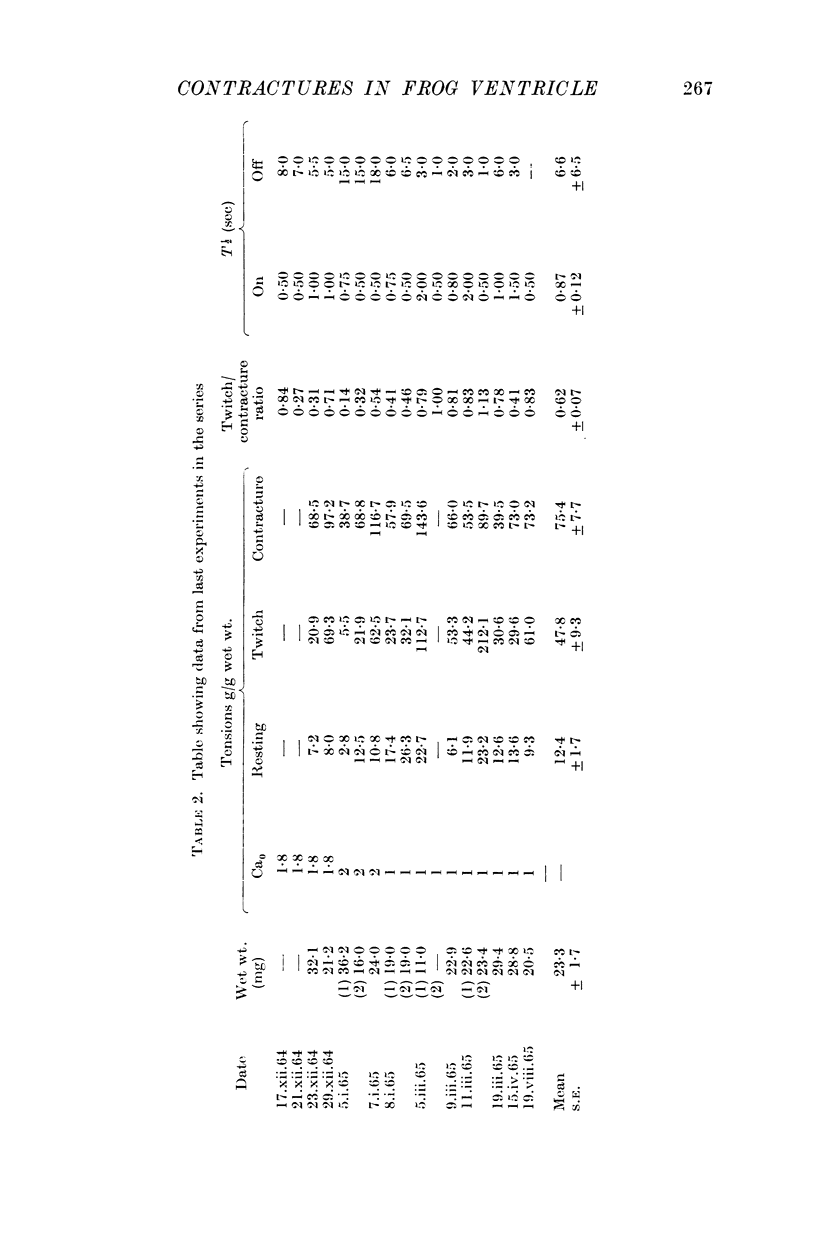
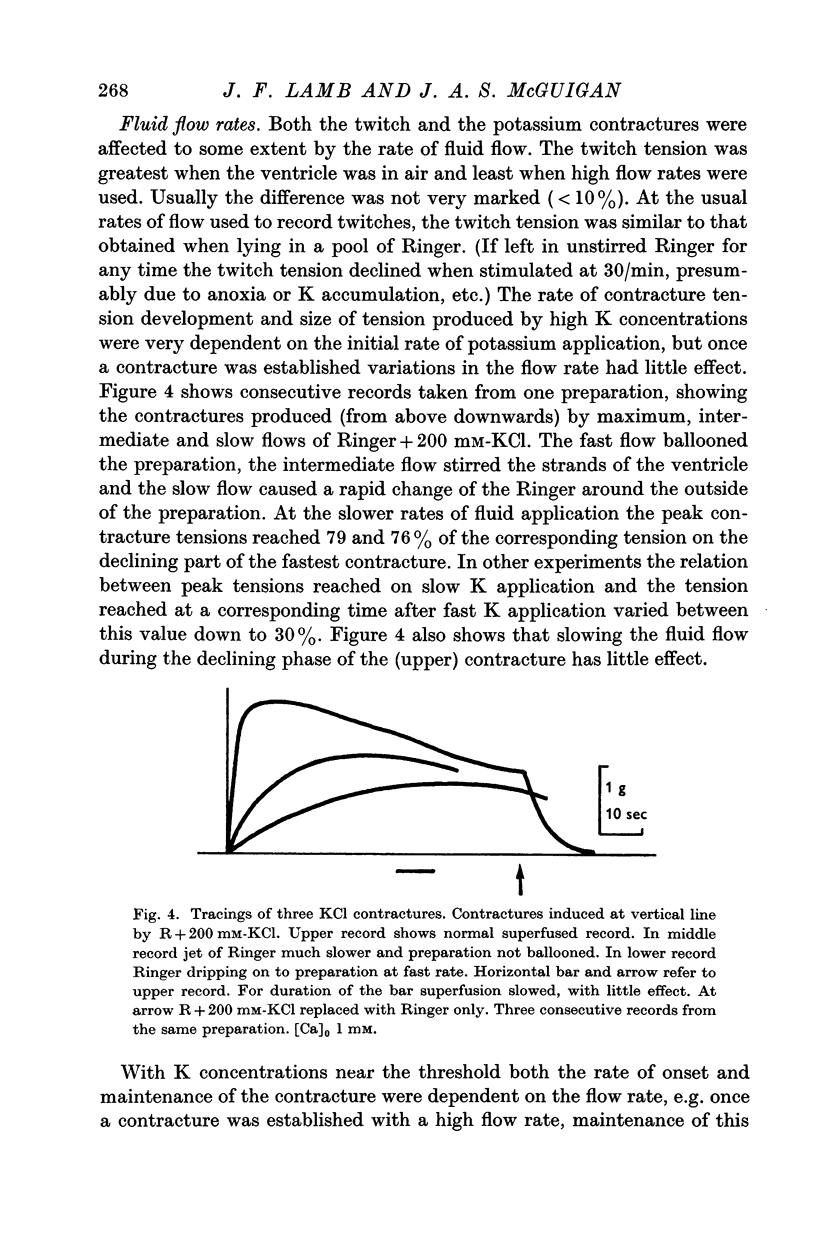
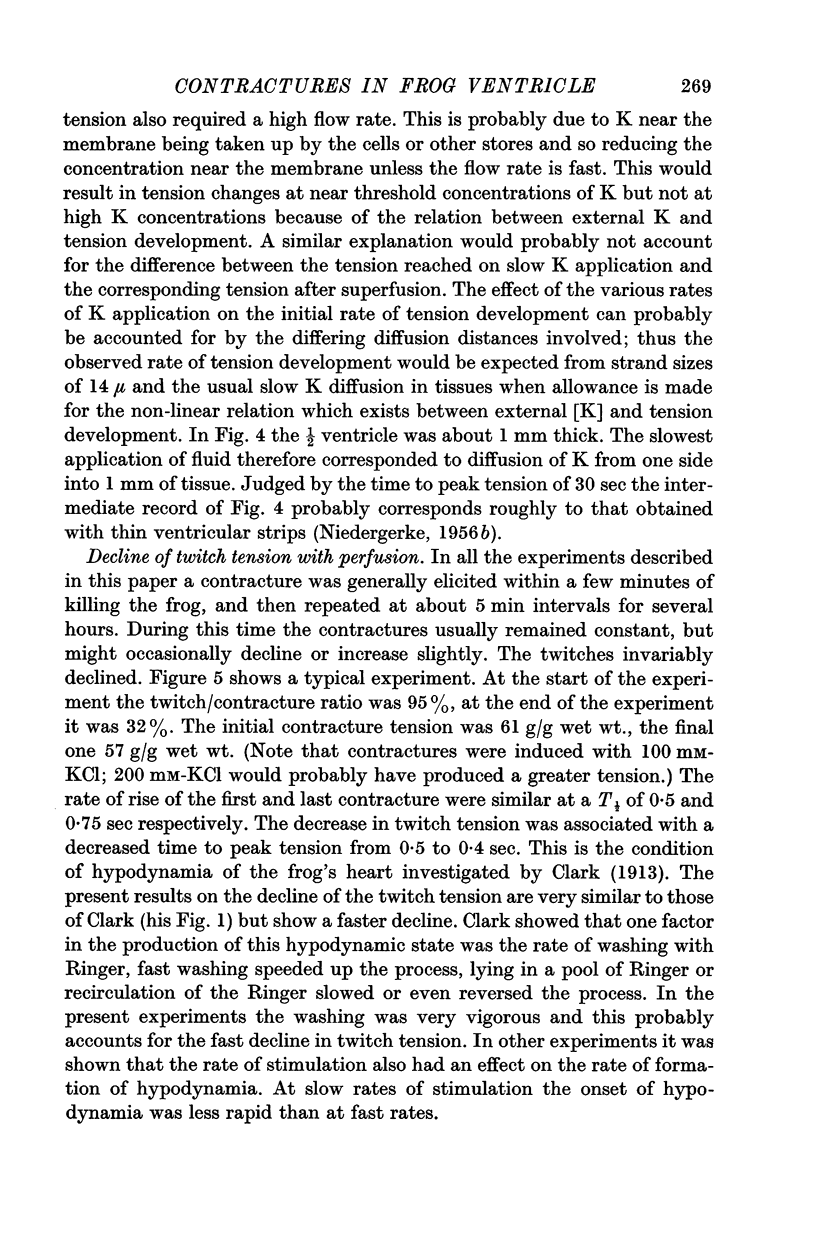
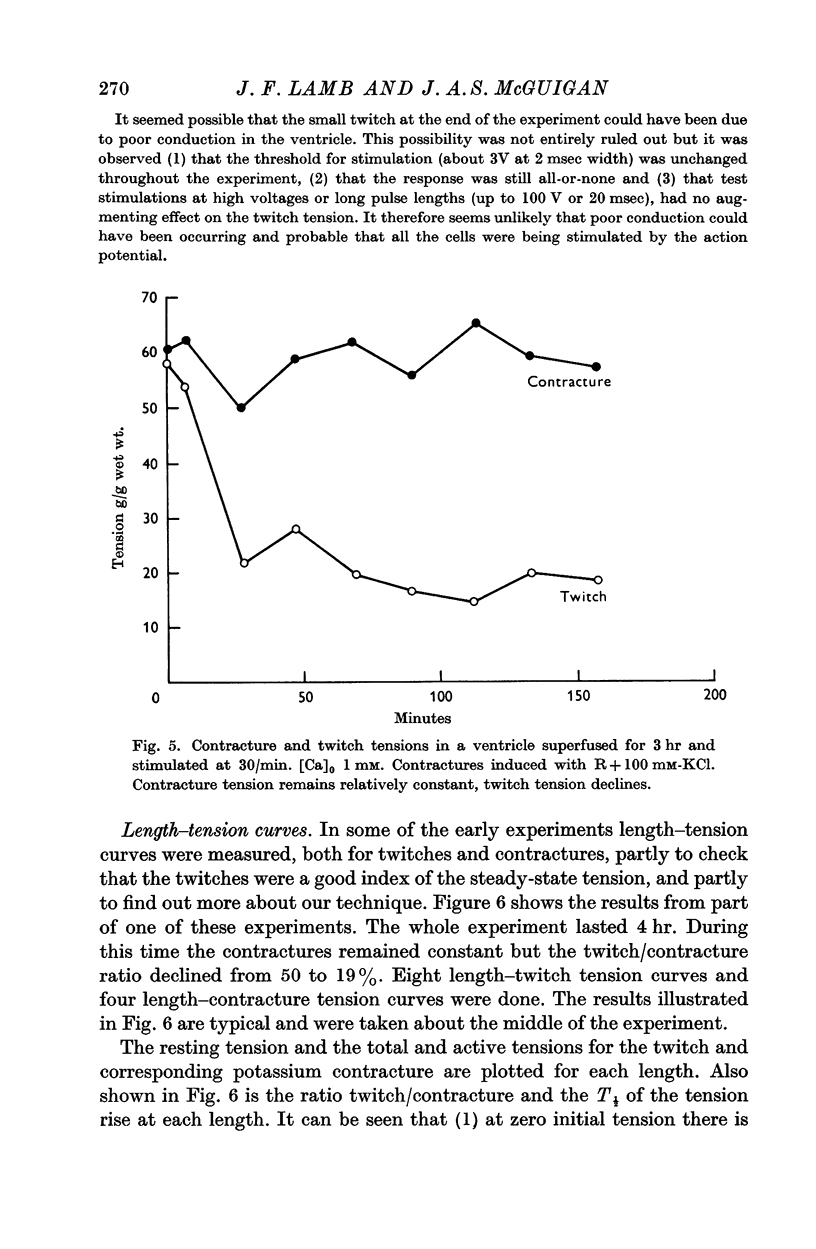

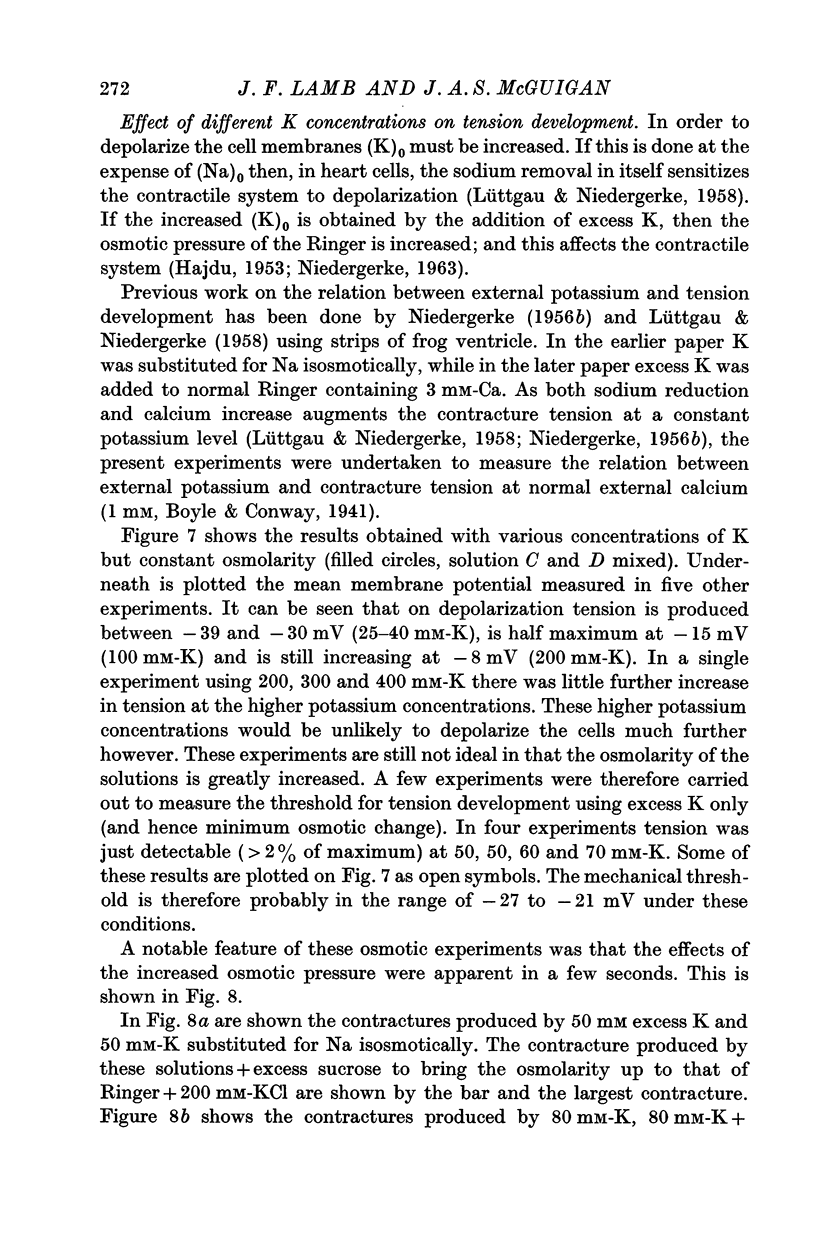
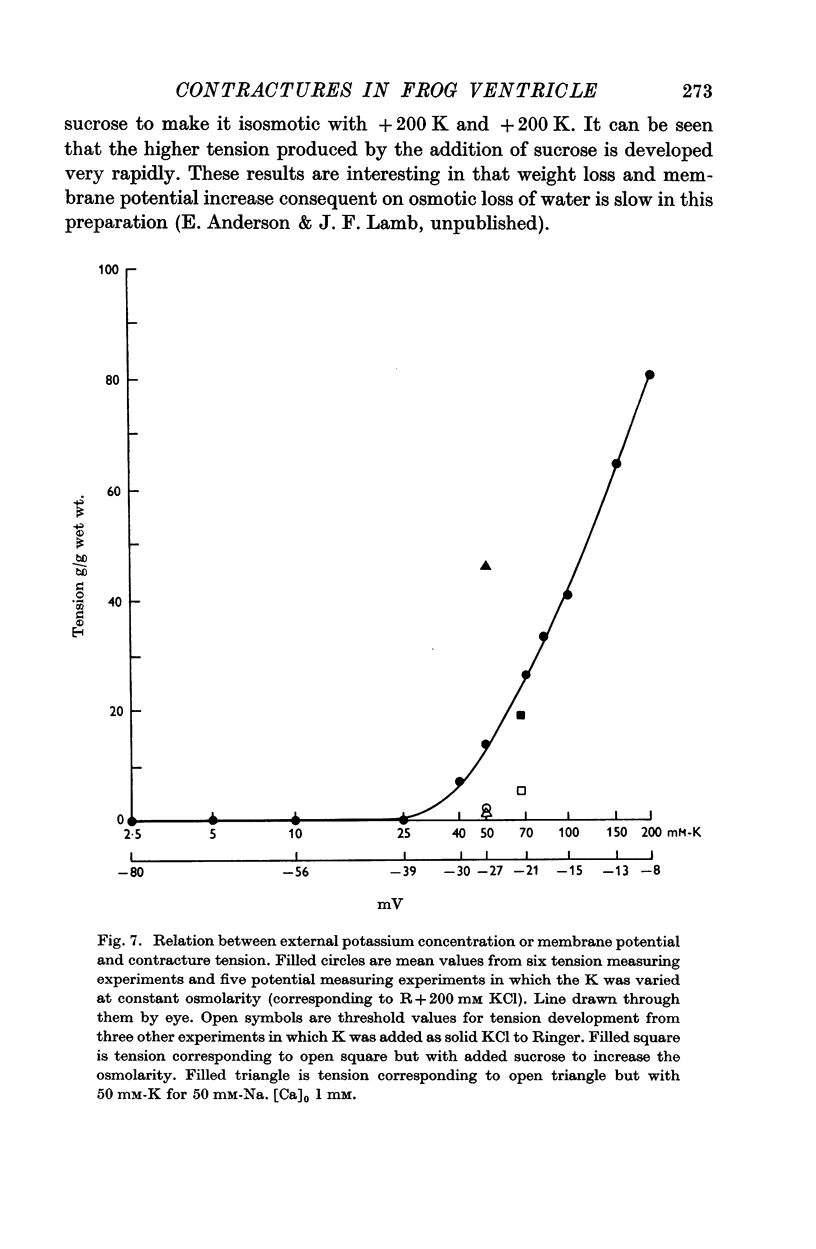
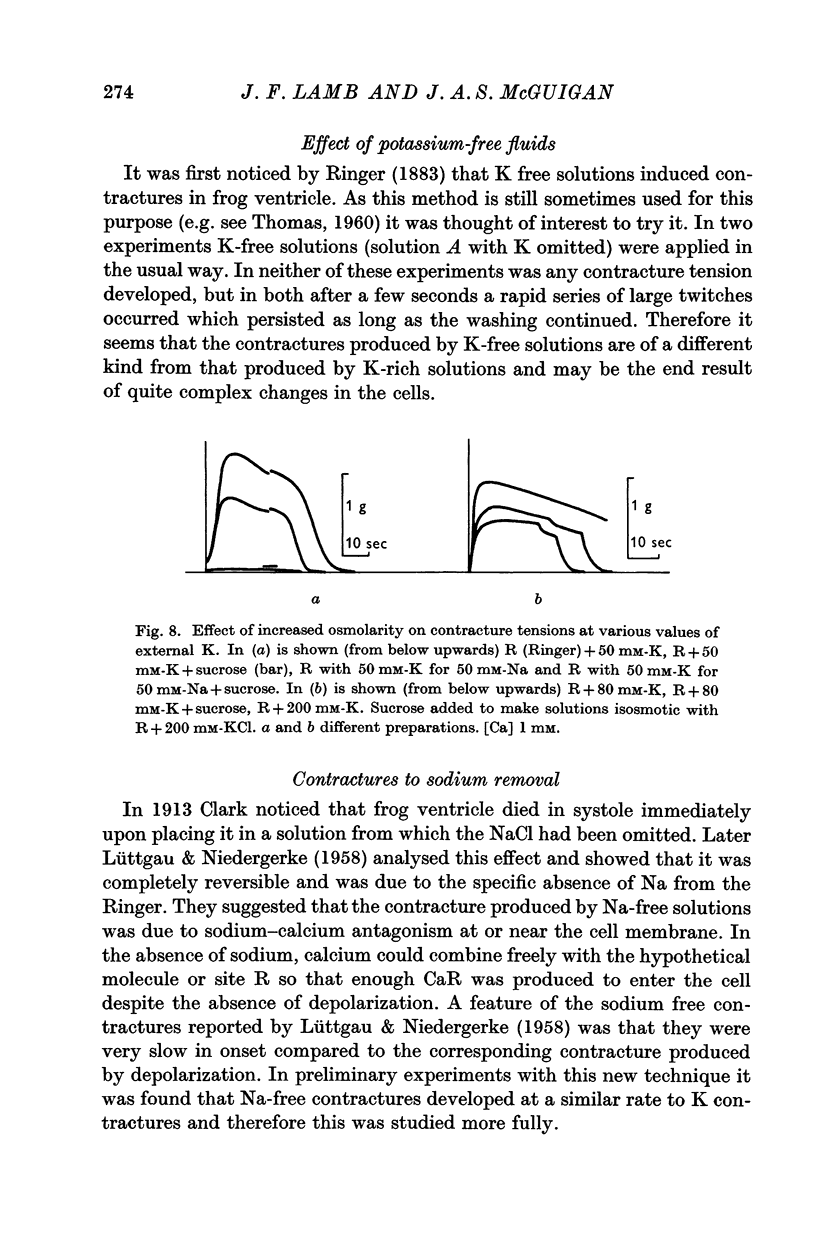
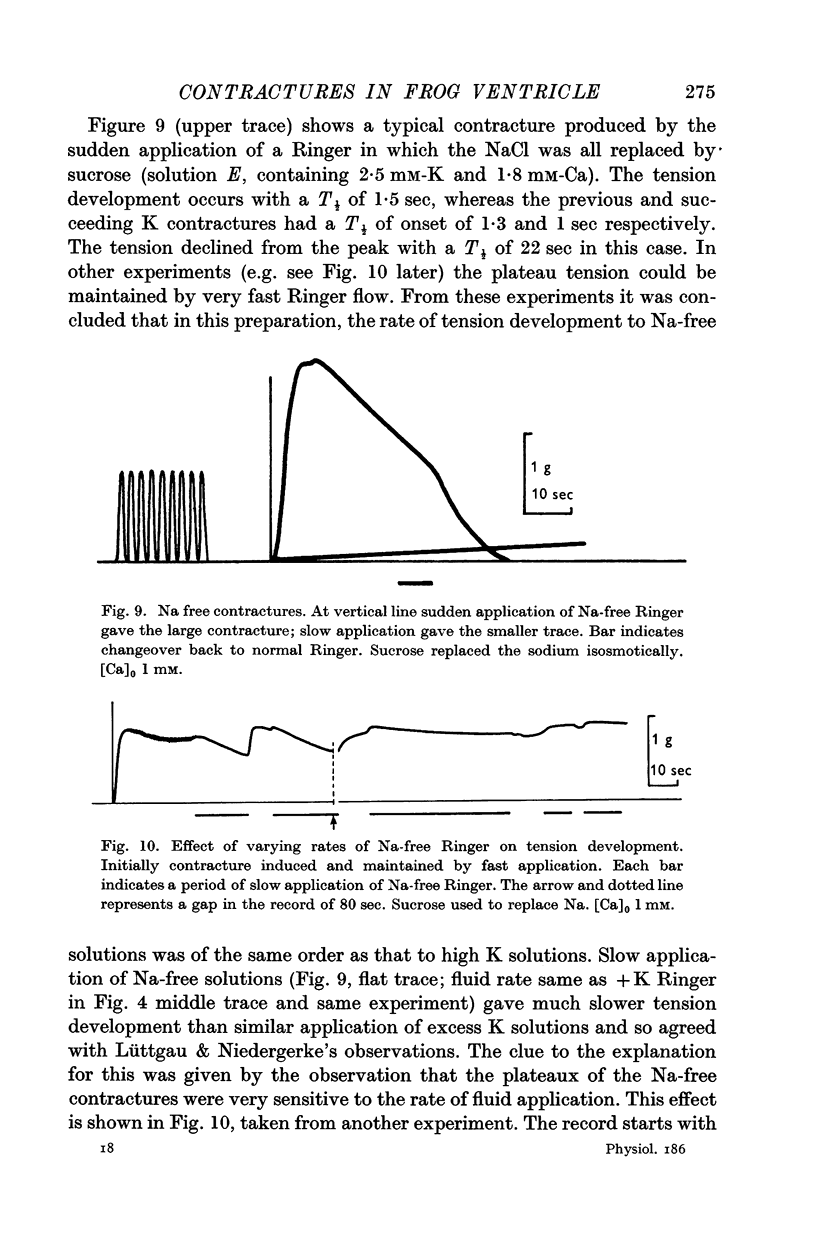
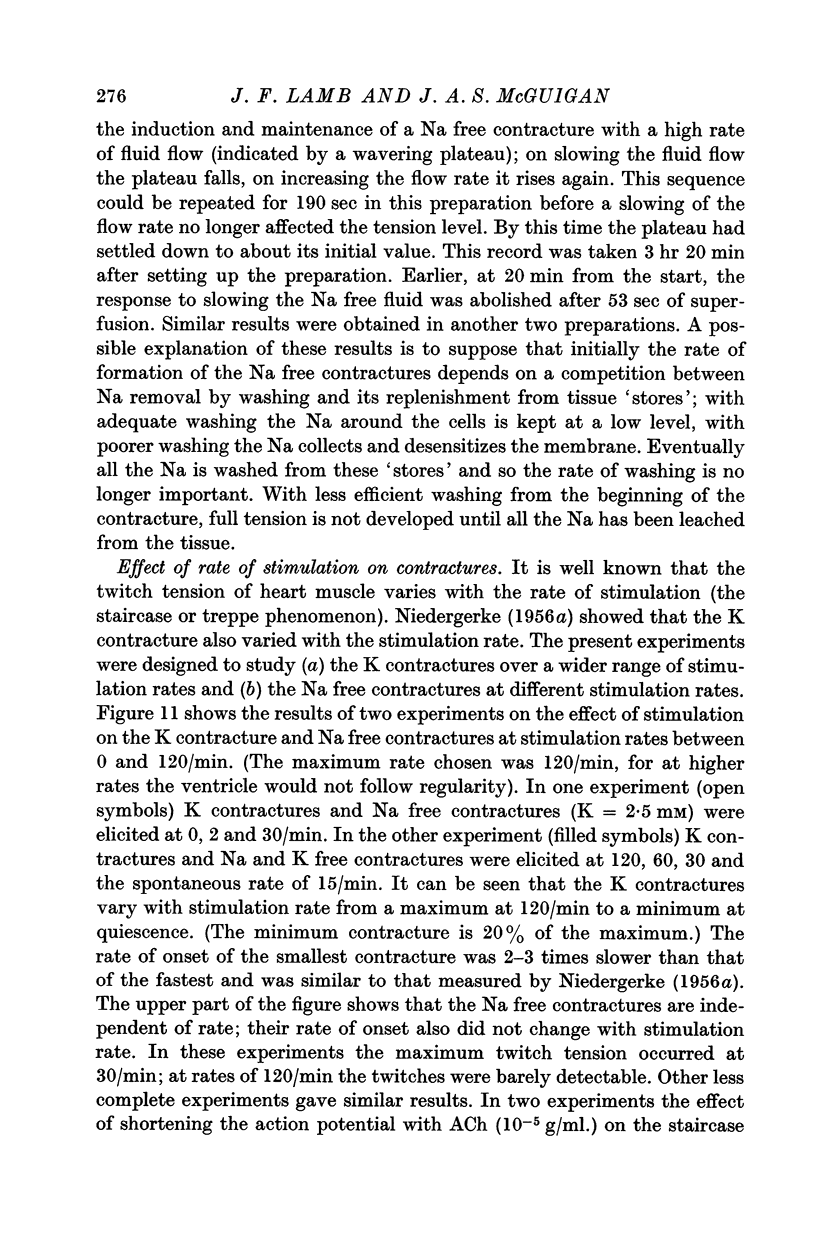
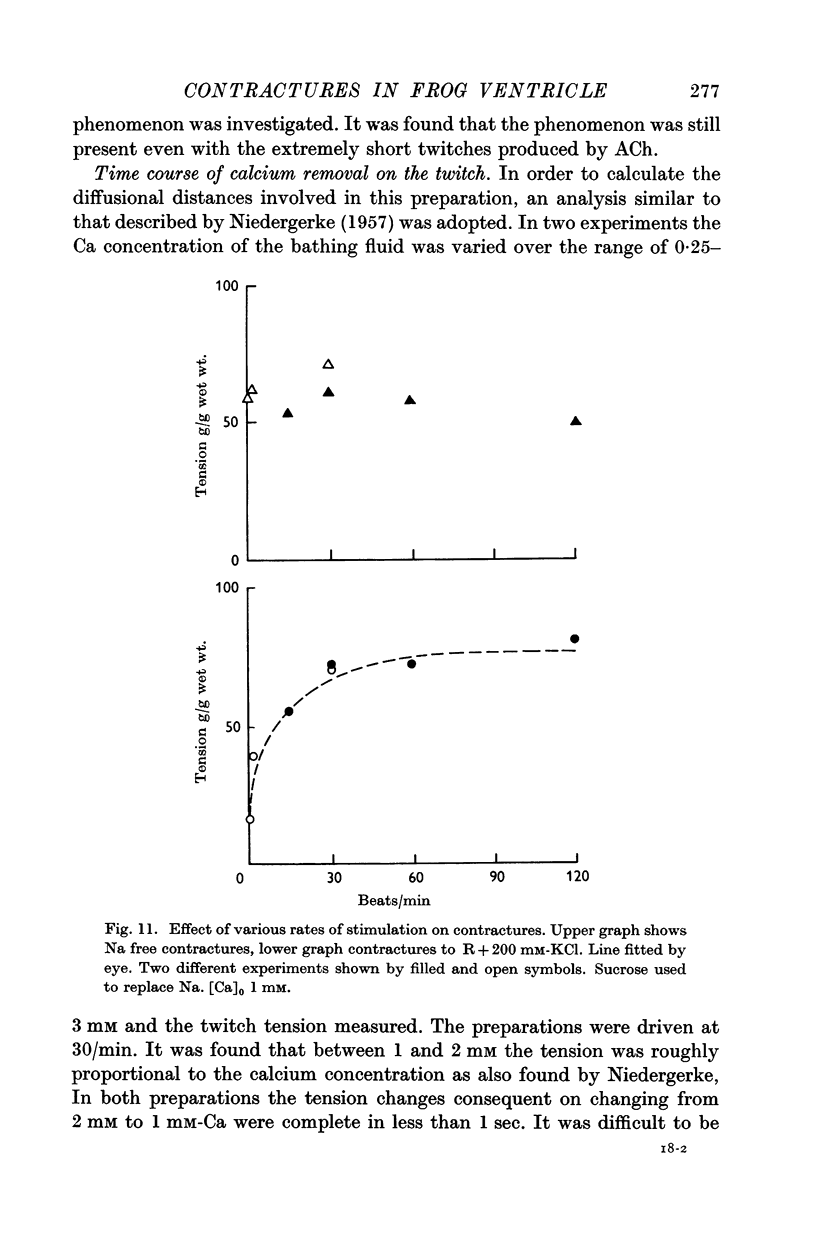
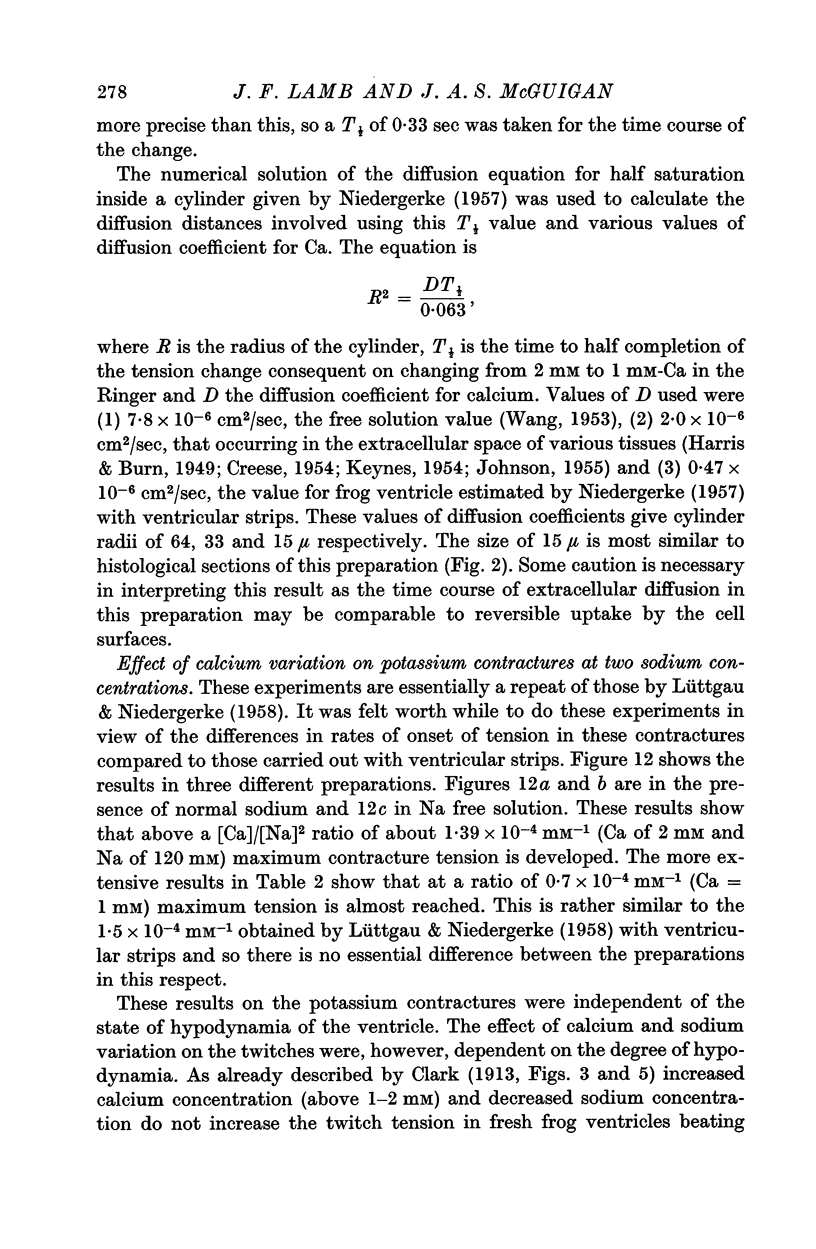
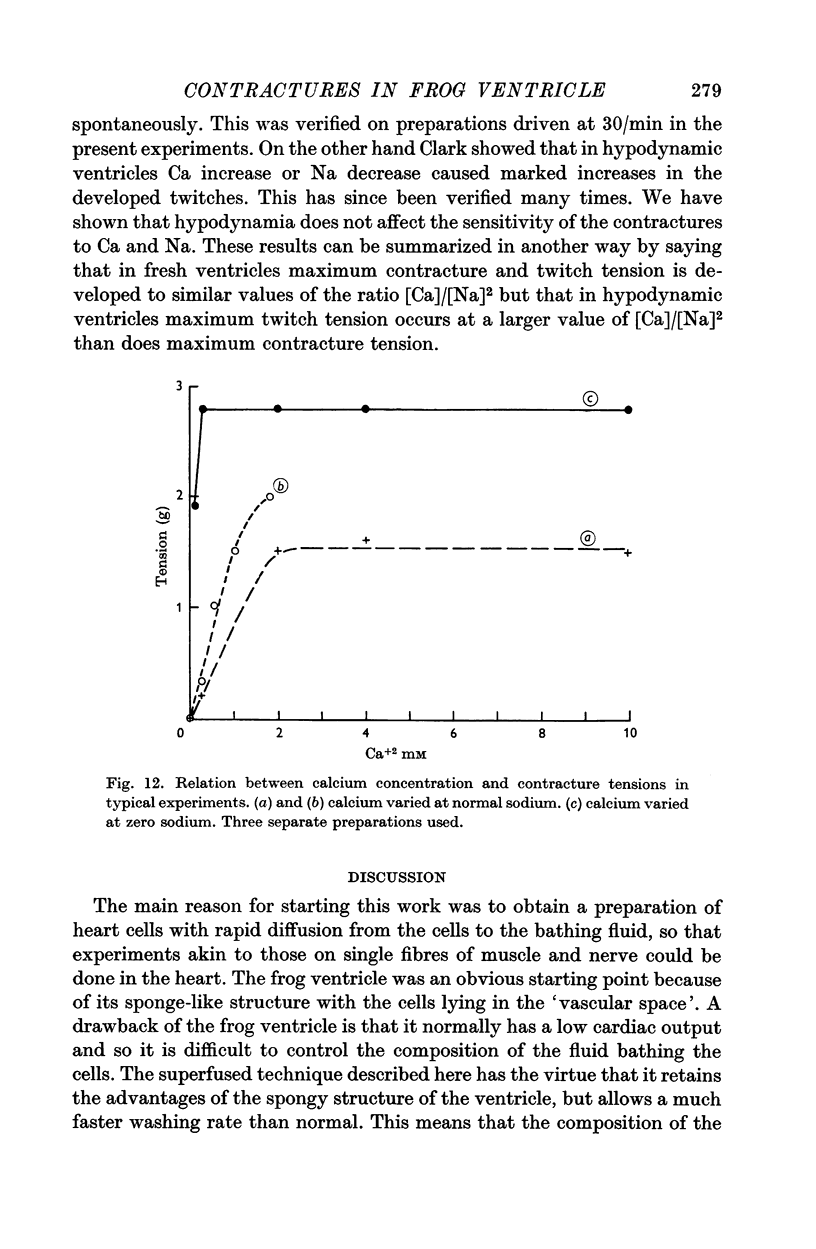
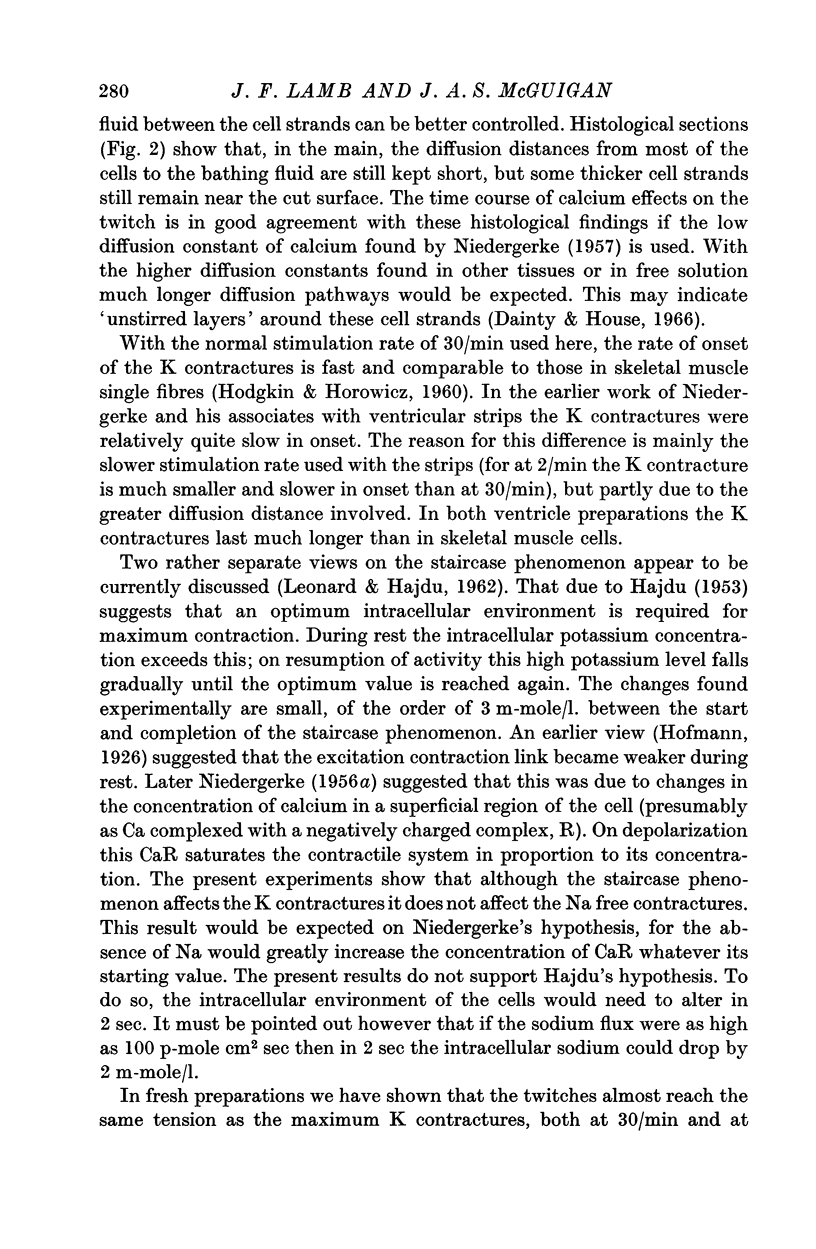
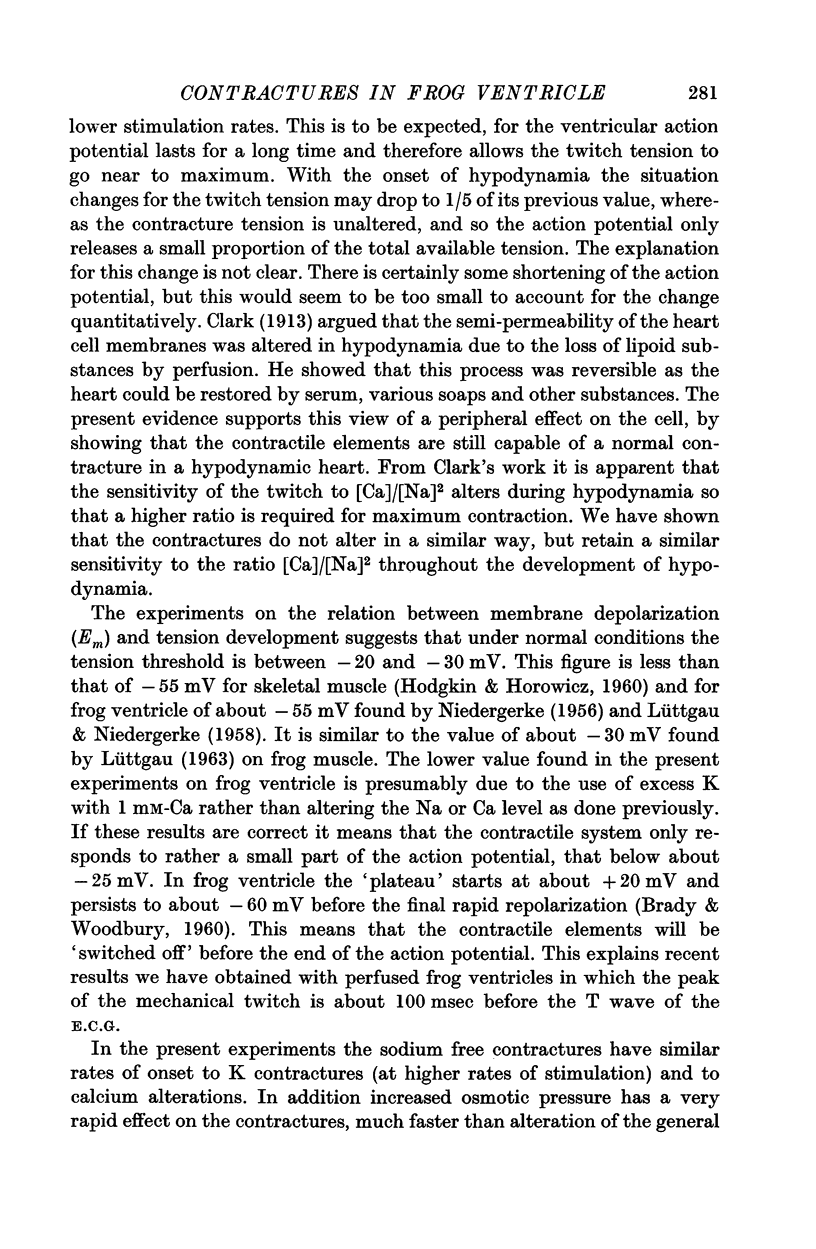
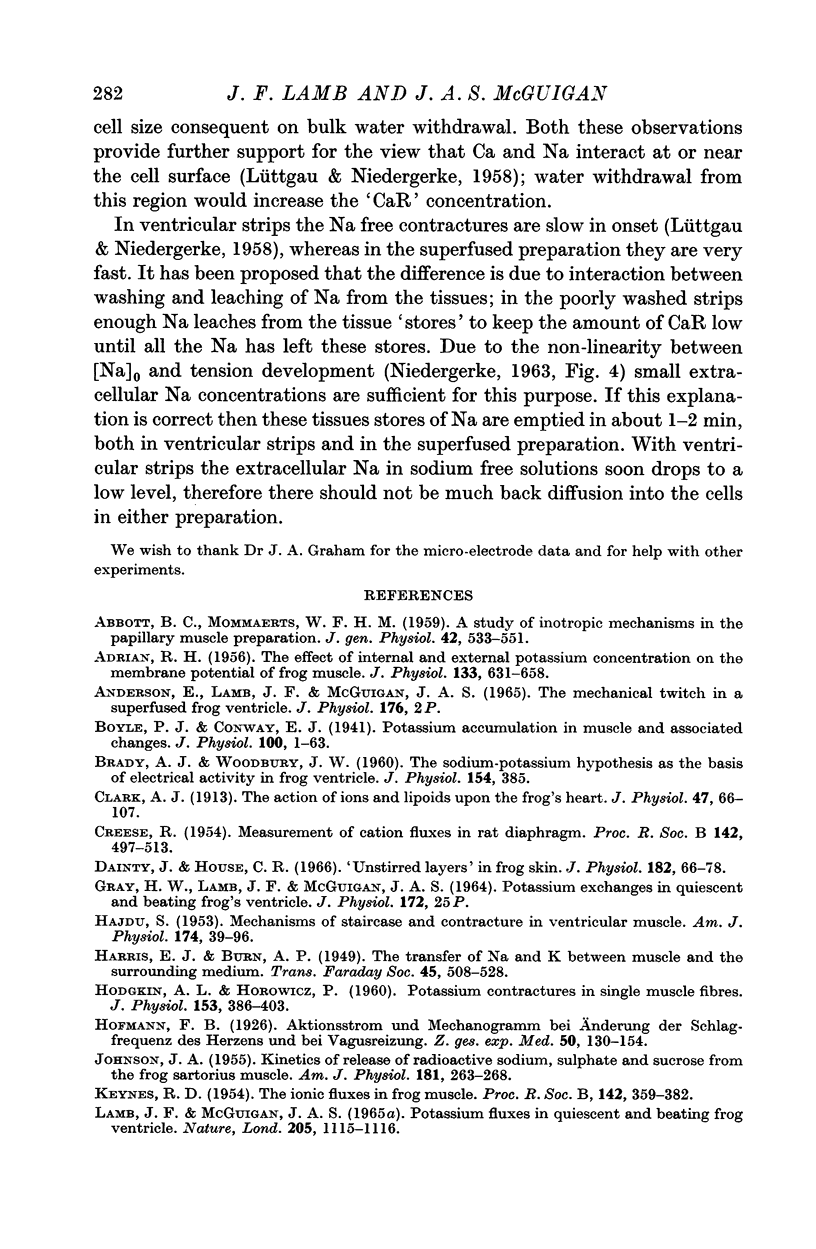
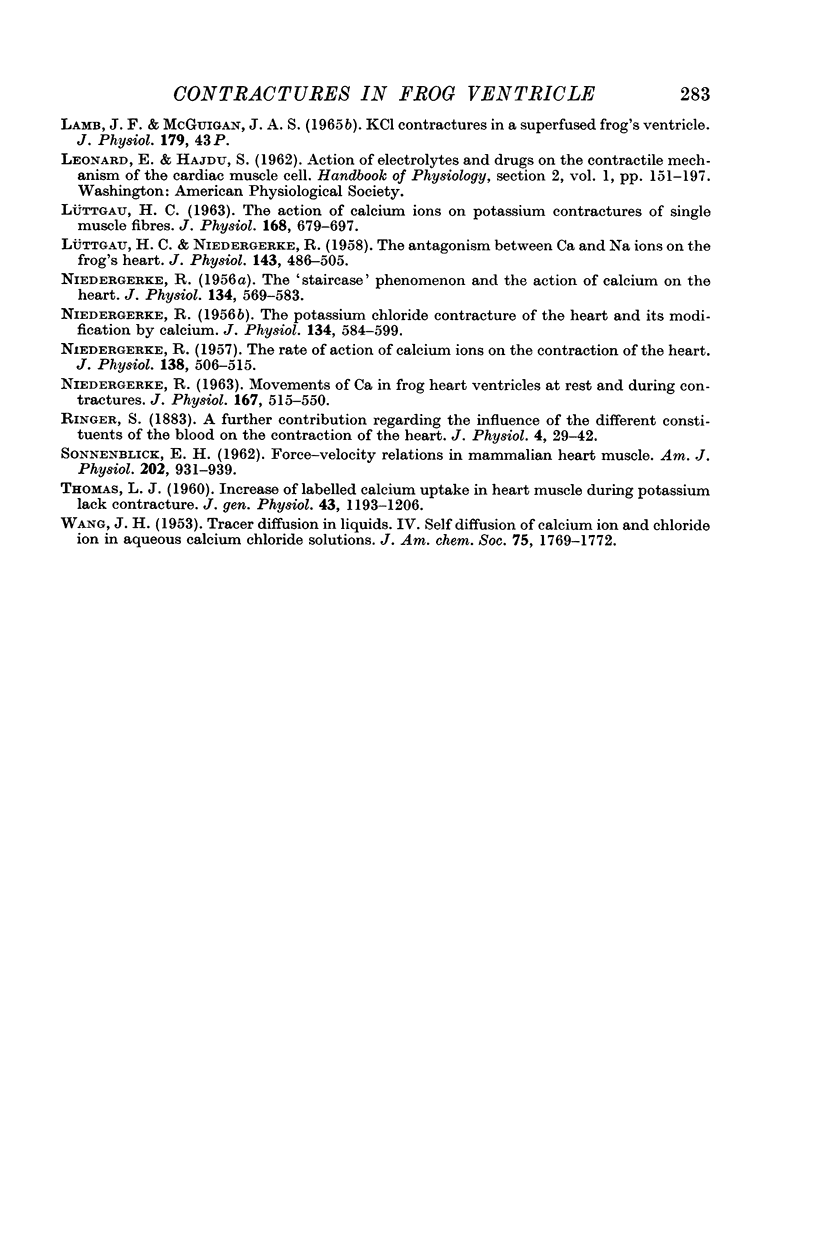
Selected References
These references are in PubMed. This may not be the complete list of references from this article.
- ABBOTT B. C., MOMMAERTS W. F. A study of inotropic mechanisms in the papillary muscle preparation. J Gen Physiol. 1959 Jan 20;42(3):533–551. doi: 10.1085/jgp.42.3.533. [DOI] [PMC free article] [PubMed] [Google Scholar]
- ADRIAN R. H. The effect of internal and external potassium concentration on the membrane potential of frog muscle. J Physiol. 1956 Sep 27;133(3):631–658. doi: 10.1113/jphysiol.1956.sp005615. [DOI] [PMC free article] [PubMed] [Google Scholar]
- Boyle P. J., Conway E. J. Potassium accumulation in muscle and associated changes. J Physiol. 1941 Aug 11;100(1):1–63. doi: 10.1113/jphysiol.1941.sp003922. [DOI] [PMC free article] [PubMed] [Google Scholar]
- Brady A. J., Woodbury J. W. The sodium-potassium hypothesis as the basis of electrical activity in frog ventricle. J Physiol. 1960 Dec;154(2):385–407. doi: 10.1113/jphysiol.1960.sp006586. [DOI] [PMC free article] [PubMed] [Google Scholar]
- CREESE R. Measurement of cation fluxes in rat diaphragm. Proc R Soc Lond B Biol Sci. 1954 Sep 27;142(909):497–513. doi: 10.1098/rspb.1954.0039. [DOI] [PubMed] [Google Scholar]
- Clark A. J. The action of ions and lipoids upon the frog's heart. J Physiol. 1913 Oct 17;47(1-2):66–107. doi: 10.1113/jphysiol.1913.sp001614. [DOI] [PMC free article] [PubMed] [Google Scholar]
- Dainty J., House C. R. Unstirred layers in frog skin. J Physiol. 1966 Jan;182(1):66–78. doi: 10.1113/jphysiol.1966.sp007809. [DOI] [PMC free article] [PubMed] [Google Scholar]
- HODGKIN A. L., HOROWICZ P. Potassium contractures in single muscle fibres. J Physiol. 1960 Sep;153:386–403. doi: 10.1113/jphysiol.1960.sp006541. [DOI] [PMC free article] [PubMed] [Google Scholar]
- JOHNSON J. A. Kinetics of release of radioactive sodium, sulfate and sucrose from the frog sartorius muscle. Am J Physiol. 1955 May;181(2):263–268. doi: 10.1152/ajplegacy.1955.181.2.263. [DOI] [PubMed] [Google Scholar]
- KEYNES R. D. The ionic fluxes in frog muscle. Proc R Soc Lond B Biol Sci. 1954 May 27;142(908):359–382. doi: 10.1098/rspb.1954.0030. [DOI] [PubMed] [Google Scholar]
- LUETTGAU H. C. THE ACTION OF CALCIUM IONS ON POTASSIUM CONTRACTURES OF SINGLE MUSCLE FIBRES. J Physiol. 1963 Oct;168:679–697. doi: 10.1113/jphysiol.1963.sp007215. [DOI] [PMC free article] [PubMed] [Google Scholar]
- LUTTGAU H. C., NIEDERGERKE R. The antagonism between Ca and Na ions on the frog's heart. J Physiol. 1958 Oct 31;143(3):486–505. doi: 10.1113/jphysiol.1958.sp006073. [DOI] [PMC free article] [PubMed] [Google Scholar]
- Lamb J. F., McGuigan J. A. Potassium fluxes in quiescent and beating frog ventricle. Nature. 1965 Mar 13;205(976):1115–1116. doi: 10.1038/2051115a0. [DOI] [PubMed] [Google Scholar]
- NIEDERGERKE R. MOVEMENTS OF CA IN FROG HEART VENTRICLES AT REST AND DURING CONTRACTURES. J Physiol. 1963 Jul;167:515–550. doi: 10.1113/jphysiol.1963.sp007166. [DOI] [PMC free article] [PubMed] [Google Scholar]
- NIEDERGERKE R. The potassium chloride contracture of the heart and its modification by calcium. J Physiol. 1956 Dec 28;134(3):584–599. doi: 10.1113/jphysiol.1956.sp005667. [DOI] [PMC free article] [PubMed] [Google Scholar]
- NIEDERGERKE R. The rate of action of calcium ions on the contraction of the heart. J Physiol. 1957 Oct 30;138(3):506–515. doi: 10.1113/jphysiol.1957.sp005867. [DOI] [PMC free article] [PubMed] [Google Scholar]
- NIEDERGERKE R. The staircase phenomenon and the action of calcium on the heart. J Physiol. 1956 Dec 28;134(3):569–583. doi: 10.1113/jphysiol.1956.sp005666. [DOI] [PMC free article] [PubMed] [Google Scholar]
- Ringer S. A further Contribution regarding the influence of the different Constituents of the Blood on the Contraction of the Heart. J Physiol. 1883 Jan;4(1):29–42.3. doi: 10.1113/jphysiol.1883.sp000120. [DOI] [PMC free article] [PubMed] [Google Scholar]
- SONNENBLICK E. H. Force-velocity relations in mammalian heart muscle. Am J Physiol. 1962 May;202:931–939. doi: 10.1152/ajplegacy.1962.202.5.931. [DOI] [PubMed] [Google Scholar]
- THOMAS L. J., Jr Increase of labeled calcium uptake in heart muscle during potassium lack contracture. J Gen Physiol. 1960 Jul;43:1193–1206. doi: 10.1085/jgp.43.6.1193. [DOI] [PMC free article] [PubMed] [Google Scholar]
- WADDELL W. R., GEYER R. P., SASLAW I. M., STARE F. J. Normal disappearance curve of emulsified fat from the blood stream and some factors which influence it. Am J Physiol. 1953 Jul;174(1):39–42. doi: 10.1152/ajplegacy.1953.174.1.39. [DOI] [PubMed] [Google Scholar]


